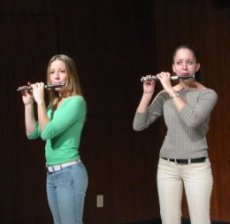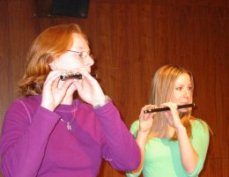| PICCOLO FAQ by |
In the last fifteen years the popularity of the piccolo has increased dramatically. Piccolo enthusiasts have demanded more published texts, method books, compositions, and competitions, and piccolo makers have responded by improving the quality and construction of the instrument. Though the instrument is small, its power is great. Poor piccolo playing can ruin the sound of an entire wind ensemble or orchestra; thus, it is beneficial to understand the instrument and its proper playing techniques. Below I have listed and answered the most common questions I receive about piccolo playing.
Piccolos these days are made either of silver or a hard wood such as crocus wood. Deciding which you should buy really depends on your particular playing situation. Metal piccolos, since they have more piercing and strident tones, are best suited for outdoor performances with wind bands. In addition, the metal piccolo is preferable because weather conditions are less damaging to the instrument. The wood piccolo, because it is less shrill and more sonorous in tone, blends better with the sounds of an orchestra or chamber ensemble.
What
is the difference between conical and cylindrical bores?
A cylindrical bore has the same diameter throughout; a conical bore tapers
slightly to the end. The cylindrical bore instrument has a thinner
sound in the bottom two octaves but improves in the third octave.
The conical bore instrument, however, has a more consistent and full-bodied
tone quality. The conical bore piccolo is preferred by most professional
piccoloists.
Does
a headjoint really make a difference?
Yes! The headjoint accounts for most of the sound and response of
your piccolo, and for this reason you should try more than one headjoint
when purchasing an instrument. Try different headjoint cuts and
carefully select the one that is best for your style of playing.
When testing head joints, use the same musical examples for each trial
and enlist the help of someone whose ears you trust.
The piccolo embouchure needs to be firmer than the flute embouchure (remember, you are playing an octave higher than on the flute), but if the embouchure is too tight the sound will not be pleasant. If you use the "smile" embouchure where the lips are pulled upward and tightly against the lips, you will definitely make a buzzing sound on the higher pitches. By keeping the lips and corners forward, the lip opening very small and round, the throat relaxed, and the air stream constant, you will achieve a good tone-although it will take time to train the muscles of your embouchure. Avoid covering too much of the embouchure hole or closing the teeth as both will create a thin, pinched tone.
Why
do intonational tendencies vary from flute to piccolo?
Again the answer lies in acoustical principles. The flute has a
cylindrical body, and the conical bore piccolo tapers slightly to the
end, thereby accounting for the differences. Most novice piccoloists
are surprised to learn that C3, C#3, D3, and G3 are flat on piccolo; indeed,
many of the notes of the fact that each piccolo's basic intonation varies.
Listening well and working assiduously with a tuner will assist you in
learning and correcting the tendencies of your particular instrument.
Why do I have such trouble playing some notes in tune?
Perhaps you are using flute fingerings for those pitches. Many piccolo
fingerings differ form the flute ones, and students of the piccolo should
make every effort to incorporate them into their playing. Seemingly
"alternate fingerings," these fingerings should almost be considered
"principal fingerings" because they ensure good intonation,
smooth finger changes, a beautiful sound that blends well, clean attacks,
and reliable soft playing.
How
do I learn these specific piccolo fingerings?
The "Let's Talk Picc" column of Flute Talk magazine recently
printed two good sources: Jan Gippo's alternate fingering chart and Morgan
Williams' trill chart. In addition, you can refer to Stephen Tanzer's
A Basic Guide to Fingerings for the Piccolo. Piccolo enthusiasts
should be aware that a comprehensive publication devoted to principal
and alternate fingerings of the piccolo is slated to appear in print by
the end of the year 2001. It is truly worth the effort to learn
which fingerings work best on your instrument-- both you and your conductor
will be pleased with the results!
Do
I have to practice piccolo since it is so similar to the flute?
Some basic techniques are similar, but it is best to think of the piccolo
as a distant instrument. In order to be proficient on the instrument,
you must produce a good tone throughout, play well in tune, learn alternate
fingerings, develop flexibility, and articulate cleanly. These
skills cannot be achieved by practicing flute alone. Instead, you
should continue your flute practice and add piccolo practice to the end
of the session when you are warmed up. Over time you will be able
to play for longer periods of time without fatigue or tension.
Are
there any method books specifically for piccolo?
Many flute methods and studies are well-suited to helping the piccolist
achieve a flawless technique. In recent years, though, many piccolo
method books have become available, and they address specific problem
areas and difficulties of the instrument. One of the most popular
is A Piccolo Practice Book by Trevor Wye and Partricia Morris (Novello,
$33.95). Clement Barone offers his Learning the Piccolo (Little
Piper, $10.99) while French piccoloist Jean-Louis Beaumaudier has contributed
his Exercises (Billaudot). Other less recent methods are
Jean Louis Tulou's Popular Method for the Piccolo (Ricordi, $10.95)
and Towarnicki's Technical Studies for the Piccolo (P.W.M., $51.50).
This list is by no means a comprehensive one.
Which
composer first included the piccolo in symphony?
Although the piccolo first appeared in the orchestra about 1700, the first
separate and matured symphonic piccolo part came in 1807, when Beethoven
wrote for the piccolo in the last movement of his Symphony No. 5.
In addition, he included it in the finale of his Symphony No. 9. By 1813
the piccolo was a regular member of opera orchestras. Rossini used
the piccolo in all of his operatic pieces and even gave solos to the piccolo
in the opera overtures, but it was not until 1887, with the third movement
of Tchaikovsky's Symphony No. 4, that the piccolo received its first orchestral
solo.
Are
there any books of piccolo band excerpts?
There is a new publication compiled by Nan Raphael called In the Limelight:
Piccolo Solos and Technical Passages from the Symphonic Band Repertoire.
It is published by FLUTE.NET publications. This book contains excerpts
from seventy-five of the most often performed symphonic band works, and
it also includes some of the most popular Db piccolo parts.
| If you would like to be added to the TSMP Email Mailing List and receive periodic notifications of new articles and updates to this website, then please email TSMP.
The Texas School Music
Project is a source for ideas and information
concerning pedagogical
practices in the music classroom or rehearsal hall. The TSMP is a service provided to
all music specialists by the faculty
of
the Department of Music
at Stephen F. Austin State University. Copyright ? 2002, Department of Music at Stephen F. Austin State University |
_small.jpg)
